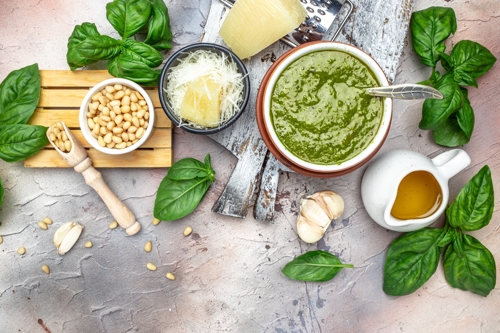
According to some food historians, pesto originated in ancient Rome, where they used cheese, pine nuts, oil, salt and some aromatic herbs. A version with walnuts and garlic is believed to have gained traction in the Middle Ages, when sailors visiting Genova and Liguria insisted on incorporating the bulbous flowing plant because they thought it would prevent illness during their sea voyages.
▫️
But it was not until 1863, when Giovanni Battista Ratto published his book, “La Cucina Genovese” (“Genovese Cuisine”), that the first published recipe of “Pesto alla Genovese” appeared (and it supposedly hasn’t undergone significant changes since). The traditional ingredients are basil, extra virgin olive oil, garlic, pine nuts, parmesan and coarse salt. And to prepare an authentic version, a marble mortar and pestle are required. And, interestingly, the words pestle and pesto derive from the Italian verb “pestare” — which means to crush something to a powder.
▫️
We found it crushing that FELICE, an Italian restaurant located at 366 South Rosemary Avenue, in West Palm Beach (Florida), was asking $28 (pre-tax/tip) for its “TRECCE AL PESTO — braided pasta, garlic, Parmigiano-Reggiano, pine nuts, arugula, basil pesto sauce [veg].” But a guest insisted that we try it.
▫️
While the presentation was a bit “messy,” and the texture of the braided (“trecce”) pasta was softer than we would have liked, the real problem was with the accompanying sauce. A guest remarked that the pesto didn’t taste or smell right; that it was akin to something that “came out of a jar.” For about $34 (post-tax/tip) we thought it gave us braids in the belly, and rated it an “F.”
▫️
How’s that for jarring?
.
.
.
#lucasaferrara @felice.restaurants #pasta #pastas #restaurant #restaurants #southflorida #food #foods #foodie #foodies #foodreview #foodreviews #westpalmbeach #felice #italianfood #italianrestaurant #italianrestaurants #pesto #trecce #treccepasta #pinenuts #garlic #basil #pestosauce #sauce #sauces
